Avail shared in a blog post that 354,605 wallet addresses are eligible to claim the 600 million tokens in their “unification drop.”
Avail, Blockchain Data Availability Project, Sketches Out Eligibility for Token Airdrop
A screenshot of a document describing the eligibility criteria for the airdrop was posted on the social-media platform X by the user @Bitcoineo, and Avail’s public-relations team flagged the to tweet to CoinDesk, describing it as a “leak.”
Breakout Of The Year? Crypto Analyst Predicts Where NEAR Is Headed Next
The price of Near Protocol’s native token, NEAR, has been on an upward momentum recently, with a crypto analyst projecting further price increases and suggesting that the coin could see a surge to more than $10 soon.
Near Protocol Price Poised For $10 Surge
Popular crypto trader and analyst, identified as Bluntz on X (formerly Twitter) has unveiled a major price prediction for NEAR. The analyst disclosed that the price of NEAR is exhibiting historical patterns indicative of a bullish rally, potentially surpassing $10.
$near turbo sends here imo pic.twitter.com/4o28UEsfE1
— Bluntz (@Bluntz_Capital) April 3, 2024
Bluntz, a pseudonymous analyst known for his eerily accurate prediction of Bitcoin (BTC) in June 2018, forecasted that the price of BTC would hit a bottom out at $3,200 after reaching an all-time high of $20,000 at the time. True to his foresight, Bitcoin dropped to around the projected price target by December of the same year.
Now, using technical analysis based on the Elliott Wave principle, Bluntz has shared a price chart displaying Near protocol’s potential rally to over $10.
The Elliott Wave theory, developed by Ralph Nelson Elliott is a technical methodology that analyzes recurrent and long-term price patterns related to persistent changes in investor sentiment and psychology. This technical tool is used to predict the price movements of cryptocurrencies based on greed and fear.
Bluntz provided two charts depicting Near Protocol’s price movements against Tether (USDT) and another against Bitcoin.
In both charts, Near Protocol had undergone a sequence of price fluctuations, moving between green and red zones before exhibiting strong price fundamentals that could potentially propel its price above $10. The crypto analyst has pinpointed a projected timeline for this price surge around mid April, specifically before the 15th.
Insights Into NEAR’s Recent Price Movements
Over the past month, the price of Near Protocol has been on a steady upward trend, boasting an impressive 26% increase. Moreover, the cryptocurrency’s total market capitalization has risen by over 6%, accompanied by a 25% increase in its 24-hour trading volume.
At the time of writing, Near Protocol is trading at $7.09, reflecting a significant increase of 5.89% in just one day, according to CoinMarketCap. These developments highlight the increasing appeal and demand for the popular token within the dynamic crypto space.
Illia Polosukhin, co-founder of Near Protocol has also commended the NEAR team’s consistent efforts in maintaining the cryptocurrency’s steady growth and development over the past few months. Polosukhin noted that due to the team’s dedication, Near Protocol’s capacity has surged by 50%, ensuring a more effective network to serve users.
Featured image from Pexels, chart from TradingView
DWF Labs Invests $10M in TokenFi for AI-Push, TOKEN Crosses All-Time High
The purchase will be done over a two-year period, developers told CoinDesk.
What Is ERC-404? The Experimental Standard Whose First Token Has Rocketed 12,000% in One Week
ERC-404 allows multiple wallets to directly own a single NFT, and, in the future, create a use case where that specific exposure can be tokenized and used to take out loans or stake holdings.
Crypto Token Unlocks To Cross $700 Million In February 2024, Here Are The Culprits
February is set to be a hot point for crypto assets, with several cryptocurrencies set to release over $800 million worth of assets during the month. According to data from TokenUnlocks, 26 crypto projects are set to carry out token unlocks in February, potentially flooding the crypto market with almost $1 billion worth of crypto assets. Most of this liquidity is set to come from Avalanche (AVAX), with approximately $345 million worth of AVAX set to hit the market in the middle of February.
February 2024 Set To See Massive Crypto Unlocks
Many major projects like Aptos (APT), The Sandbox (SAND), and Avalanche (AVAX) have unlocking events scheduled for February 2024. Avalanche, for instance, is set to unlock 9.54 million AVAX tokens, representing 2.6% of the total supply on February 22. This token unlock is set to be allocated in four batches, with 2.25 million AVAX tokens going to strategic partners, 1.67 million tokens to the foundation, 4.50 million tokens to the Avalanche team, and 1.13 million tokens as airdrops.
Aptos (APT) will unlock 7.34% of its total supply on February 11 to the tune of 24.84 million APT tokens worth $228.55 million. In the same vein, metaverse platform The Sandbox will unlock $205.59 million SAND tokens, representing 9.19% of its circulating supply, on February 14. At the time of writing, these tokens are worth $90.46 million.
Ethereum L2 blockchain Optimism is also set to unlock 24.16 million OP tokens worth $71.51 million on February 29. This represents 2.52% of its total supply.
Other notable tokens also set for unlock include SUI, Algorand (ALGO), ApeCoin (APE), MANTA, and AGIX. Once unlocked, these tokens are free to be sold on the open market
How Will These Unlocks Impact Prices And Investors?
Crypto unlocks among altcoins are not a new phenomenon in the crypto industry, and they tend to have both positive and negative impacts on the price of such crypto assets. However, once those locked tokens are unlocked, they can enter the open market.
This means that a large supply of tokens may become available for trading simultaneously. If any of those newly unlocked tokens are sold right away, it can put downward pressure on the price as the supply overwhelms demand.
At the time of writing, the crypto market is at somewhat of a standstill in terms of price volatility, although some cryptocurrencies like Chainlink (LINK) are currently on substantial gains in the past seven days.
Chainlink also recently witnessed an unlock of 19 million LINK tokens worth $341 million. Following this, 16 million tokens were deposited into the crypto exchange Binance immediately, suggesting a sell-off.
How To Mint BRC-20 Tokens On The Bitcoin Network
BRC-20 tokens open doors for developers to build their own decentralized applications (dApps) with unique economies on the Bitcoin network. This fosters community engagement through internal currencies, and attracting investment through innovative token sale structures.
BRC-20 tokens are fungible tokens built on the Bitcoin network using the Ordinals protocol. It also utilizes inscriptions containing JSON (JavaScript Object Notation) data to facilitate the deployment of token contracts, minting tokens, and transferring tokens. Presently, the BRC-20 token standard offers the ability to create a BRC-20 token using the deploy function, mint a specified quantity of BRC-20 tokens using the mint function, and transfer a designated amount of BRC-20 tokens through the transfer function.
BRC-20 and ERC-20 share some similar characteristics and functional concepts, but they are not identical due to their different underlying blockchains and implementation details. One of the differences is that BRC-20 tokens operate on the Bitcoin blockchain, while ERC-20 tokens reside on the Ethereum blockchain. This leads to differences in technical implementations and transaction fees.
Related Reading: How To Buy And Trade BRC-20 Tokens On The Bitcoin Network
Similar to ERC-20 tokens, BRC-20 tokens are fungible, meaning they can be exchanged on a one-to-one basis with equal value. They can be created, transferred, and traded on the Bitcoin network using decentralized marketplaces like Magic Eden with compatible wallets and decentralized exchanges that support the BRC-20 standard.
BRC-20 tokens breathe vitality into the Bitcoin network, acting as programmable extensions that expand the scope beyond basic transfers. They empower the Bitcoin network by enabling the development of DApps, fostering communities, and facilitating ownership of real-world assets. This dynamic frontier presents exciting opportunities for engagement, incentives, and innovation.
However, it is essential to navigate the technical intricacies and embrace the evolving infrastructure. BRC-20 tokens, still a work in progress, possess tremendous potential to reshape the future of Bitcoin, unveiling a multitude of tokenized possibilities along the way.
Now, let’s dive into the exciting world of building your own BRC-20 tokens! As we discussed, platforms like Magic Eden offer a gateway to creating and trading these digital assets.
Creating BRC-20 Tokens On The Bitcoin Network
Creating BRC-20 tokens involves defining the token’s parameters, such as its name, symbol, and total supply, as well as any additional functionality you want to incorporate, such as token burning or minting restrictions. Once the smart contract is written, it needs to be compiled into bytecode and deployed onto the Bitcoin blockchain using the platform’s provided tools. This deployment process usually involves paying gas fees to execute the necessary transactions. Platforms like Magic Eden enable users to create their own BRC-20 Tokens.
First, visit the Magic Eden homepage, and click on “Connect Wallet” at the top right corner, as shown in the image below:
For the best wallets to use for BRC-20 tokens on the Bitcoin network, check here.

To initiate the creation of your BRC-20 token, it is essential to deploy it first. Adhere to the following instructions to proceed:
Next, click on the “Inscribe” button. (The Inscribe button pops up after you click on the “Mint” icon situated towards the top left of the screen).

Next, Click on the “BRC-20 ” tab at the top of the screen.

Then, follow these instructions:
Ticker: Select a four-letter phrase to serve as the unique identifier for your token. For instance, widely recognized BRC-20 tokens have utilized tickers like ORDI or OXBT. Establish the maximum quantity of tokens that will be available for minting. Specify the highest number of tokens that can be minted in a single transaction. Select the desired parameters and click on “Next”.
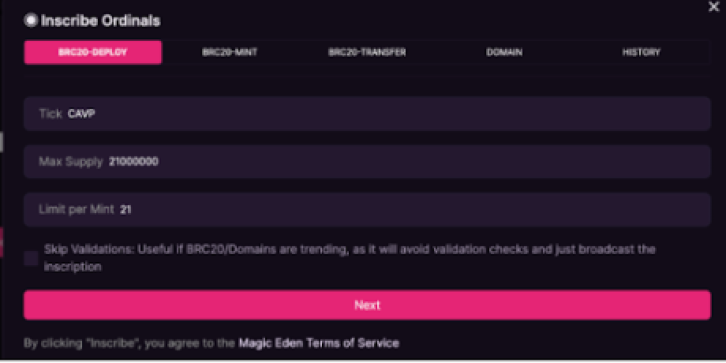
Choose the desired Bitcoin Network Fee from the options available, such as Low, Medium, or High. After making your selection, proceed by clicking the “Inscribe” button. (Ensure that the chosen ticker is not already deployed to avoid transaction failure. Magic Eden will automatically check this unless instructed otherwise).
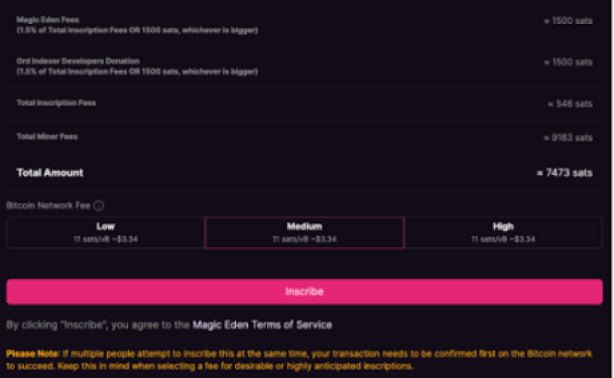
Now, wait for the transaction to be confirmed by the Bitcoin network. Confirmation times may vary.After the confirmation, check your wallet. Upon successful confirmation, you will receive a “Deploy” inscription, signifying that you can proceed to mint your tokens. The provided example illustrates a “Deploy” inscription within the Xverse wallet.
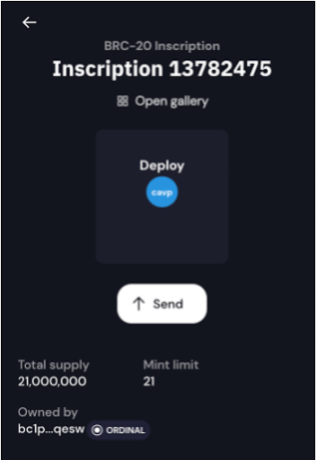
Minting Your BRC-20 Token
Having successfully deployed your BRC20 token, follow these instructions to mint it. Navigate back to the ‘Inscribe Ordinals’ modal located on the Magic Eden homepage. Within the modal, click on the “BRC-20 Mint” tab to proceed.

Enter the four-letter phrase that you deployed earlier, indicate the desired quantity of tokens you intend to mint, and specify the number of mint inscriptions you wish to generate.
Note: The maximum number you can mint per transaction has to be the same with the value set in the “Limit per mint” during the deploy process. Now, click on the “Next” button and select the network fee. After selecting the desired fee rate, click the “Inscribe” button. In the following example, 63 BRC-20 tokens are being minted in three batches of 21 each.
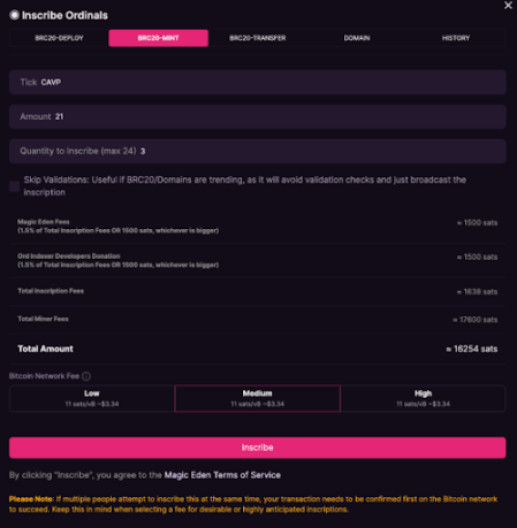
A set of mint transaction links will be provided. Please note that confirming the mint transactions once again may take some time.
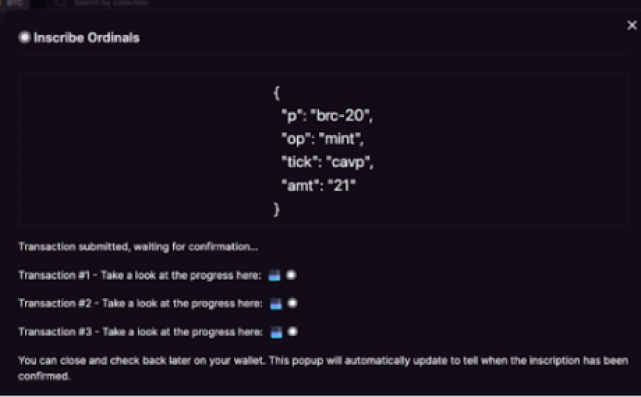
After confirmation, you will receive the mint inscriptions in your connected wallet.
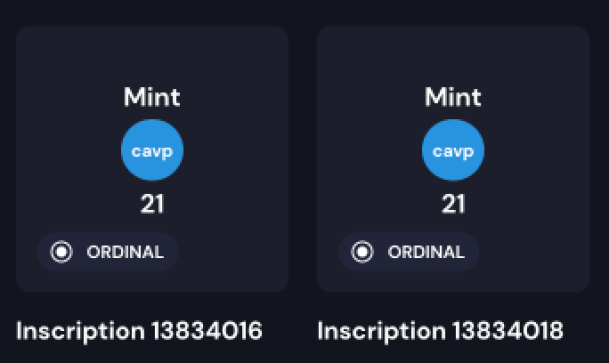
Congratulations, you have successfully created your first BRC-20 Token!
Conclusion
BRC-20 tokens offer fungible tokenization capabilities within the Bitcoin network, enabling a range of applications and use cases. As the blockchain industry progresses, both NFTs and BRC-20 tokens assume crucial roles in shaping the trajectory of digital ownership and decentralized finance (DeFi).
BRC-20 tokens introduce fungible tokenization capabilities within the Bitcoin network, providing the ability to create and exchange interchangeable tokens. This opens up a wide array of possibilities for various applications and use cases within the blockchain industry. As the blockchain ecosystem continues to advance, both NFTs and BRC-20 tokens play pivotal roles in shaping the direction of digital ownership and decentralized finance, driving innovation, and paving the way for a more inclusive and decentralized financial landscape.
How To Buy, Sell, And Trade Crypto Tokens On The Cardano (ADA) Network
[toc]
The Cardano Network is a decentralized proof-of-stake blockchain platform with smart contract support and uses its own native token ADA, just like the Ethereum blockchain. Cardano is often described as the Ethereum killer. However, Cardano also considers itself the updated version of Ethereum, which is currently the king of all altcoins, including ADA.
Cardano (ADA) The Supposed Ethereum Killer
It has been said that Cardano has anointed itself as a third-generation crypto platform which it regards to Ethereum as the second generation. Cardano has deemed itself fit to be a threat or competitor to Ethereum as they are both similar in so many ways, including the fact that Cardano (ADA) was created by one of the co-founders of Ethereum, Charles Hoskinson.
As Ethereum is having a hard time with high gas fees issues and slow transaction times, Cardano is all set up to take their share and make a name for themselves in the NFT, DeFI, and Stablecoin market. Cardano aims to be scalable and low-cost for users compared to Ethereum, its major competitor.
It enables owners of their native token ADA to help operate the network and vote on changes to the software roles. A lot of developers now use the Cardano Blockchain for Smart contracts and building decentralized applications (dApps).
Cardano Continues To Evolve: Hard Forked From Byron To Shelley
Cardano has been releasing its blockchain in stages with the aim of releasing better, cleaner, and more secure codes. They continued to evolve as the Cardano blockchain hard forked from Byron, a federated and static model, to Shelley, a more dynamic and decentralized model
A hard fork means or is described as a radical change in the blockchain, but in the case of Cardano, The blockchain hard fork was unique because instead of the blockchain radical change, it ensured a smooth transition from the old protocol to a new protocol while saving the history of the previous blocks. This means the Cardano blockchain contains the Byron blocks and after a certain transaction period, it adds the Shelley blocks.
Shelley was upgraded, and the Shelley protocol upgrade added a new feature that enabled different kinds of Smart contract use cases, which included the creation and transactions with multi-asset tokens. It also established support for the Voltaire voting mechanism. The Shelley protocol hard fork upgrade of March 2021 called “Mary” introduced native token and multi-asset support on the Cardano Blockchain.
Mary allows users to create their own tokens that run on the Cardano network natively, just like Cardano’s native token ADA. Similar to the ERC20 tokens that can be created and transacted on the Ethereum network, Native tokens will open up this same functionality to Cardano.
How Does Cardano (ADA) Work?
The Cardano (ADA) Blockchain is made up of two main components, which are the Cardano Computational Layer (CCL) and the Cardano Settlement Layer (CSL).
The Cardano Computational Layer (CCL):
The Cardano Computational Layer (CCL) consist of the Ouroboros consensus protocol and Proof of stake, which are the backbone of the Cardano blockchain. They help to run smart contracts, it also ensures compliance and security. Lastly, allow other key advanced features and functionalities such as identity recognition and blacklisting.
The Cardano Settlement Layer (CSL):
The Cardano Settlement Layer (CSL) serves as the accounting layer of the Cardano blockchain where its native token holders can send and receive their ADA immediately with minimal transaction fees.
Blockchain Industry Issues Cardano Aims To Solve
- To create a secure voting mechanism for token holders.
- To Separate accounting and computation layers.
- To create an infinitely scalable consensus mechanism.
- To use mathematics to provide a provably secure blockchain that is less susceptible to attacks.
Benefits And Advantages of Cardano (ADA) Blockchain
Decentralization: The Cardano network is designed to promote decentralization, and the founder of ADA Charles Hoskinson, is confident that the network would be 50 to 100 times more decentralized than Bitcoin.
High scalability: The recent Cardano Blockchain Vasil hard fork solves scalability issues as it introduced critical updates that streamline transaction processing, ultimately increasing the transactions per second (tps) Cardano’s blockchain can handle to significantly boost transaction processing speeds, unlike Ethereum.
Multilayer security measures: Cardano has a multilayer architecture that separates the computation layer from the accounting layer and also the Ouroboros proof of stake algorithm reduces the surface attack and ensures good security without falling short on decentralization.
Low gas fees: Unlike Ethereum, Cardano has low transaction or gas fees which makes it more appealing to users and developers.
Environmentally friendly ecosystem: Cardano is designed to be accessible to all persons, no matter their level of skill, from novices to advanced users.
Strong Community: A project is as strong as its community and Cardano has a strong community of active users, developers, researchers, and founders all work together to make the project a very good one.
How To Buy, Sell, And Trade Crypto Tokens On The Cardano (ADA) Network
To see a full picture of the Cardano ecosystem, go to CardanoCube. CardanoCude has information on the applications on the Cardano Blockchain, ranging from DEXes to Liquidity to Wallets, Marketplaces, DeFI, Infrastructure, and Launchpads, in case you want to launch a project on the Cardano Blockchain. There are also Metaverse platforms, Gaming platforms, AI tools, Community & DAO, Developer Tools, Meme Coin, and so many more.
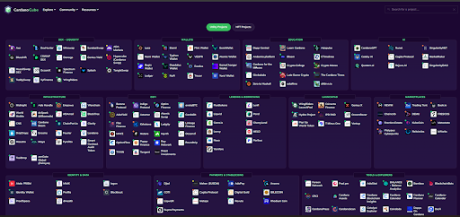
To buy and sell tokens on the Cardano (ADA) network, you need to get a wallet. The official wallet created by the Cardano developer IOG is called DAEDALUS. DAEDALUS is a desktop or PC secure wallet for the ADA cryptocurrency that downloads a full copy of the Cardano Blockchain, and it independently validates every transaction in its history, ensuring maximum security.
How To Install, Set Up, and Use DAEDALUS Wallet
Make sure you download the installation file from the DAEDALUS official website daedaluswallet.io. Once the website is open, click on “Download” and then choose your operating system: either macOS, Linux, or Windows. Start the downloading process by clicking on “Download DAEDALUS.”
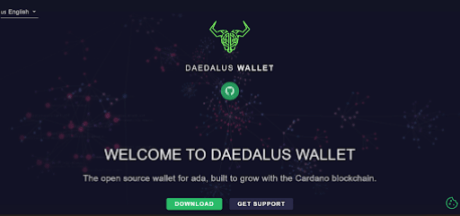
Install it, and once DAEDALUS is launched, you will need to configure the general settings and click on “Continue.” Read, and accept the terms and conditions.
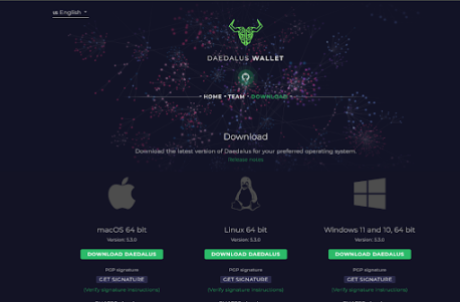
Please note that the blockchain must be completely synced before you can use your wallet.
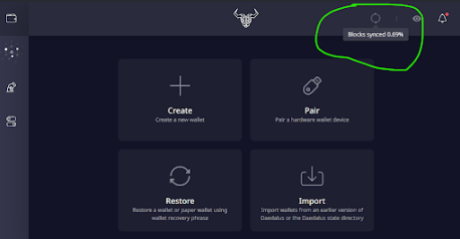
To create a new wallet, click on the “Create” button, give your wallet a “Name,” and Create your “Spending password”. You will need your spending password later to make transactions. It will also Encrypt your wallet file in the dataless directory.
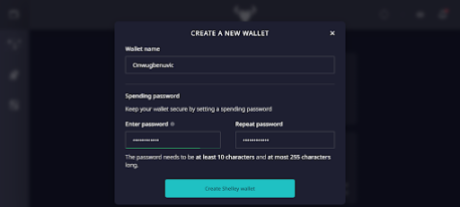
After the setup, the “Recovery phase” page will pop up, and you will be given the 24-word secret phrase that you can use to recover your account in case your laptop is stolen or broken.
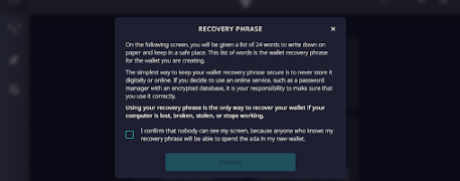
Ensure to write down your secret phrase and keep it in a safe place, after verifying your secret phrase your wallet is all set up.
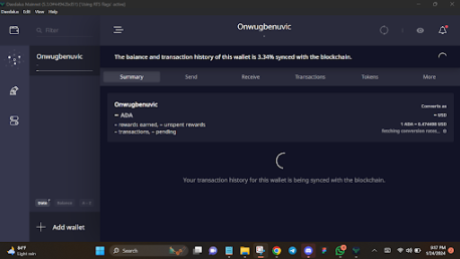
Click on “Send” to send coins and Click on “Receive” to receive coins, select one of the automatic recipient addresses to receive your coins for other exchanges.
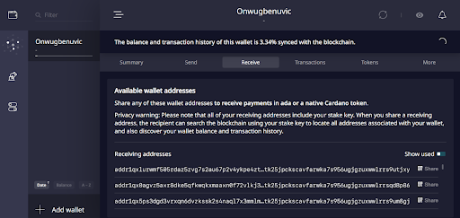
How To Use The Wallet Function On Minswap Instead Of Daedalus
Minswap is a multi-pool decentralized exchange (DEX) on Cardano (ADA) where you can swap tokens with minimal time, cost, and maximum ease.
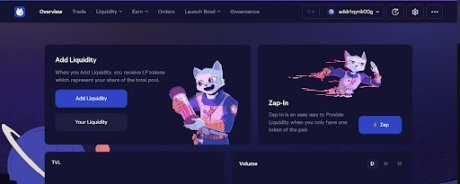
The Minswap website is user-friendly and easy to trade on. Go to the website, click on “Trade,” then click on “Connect wallet.”
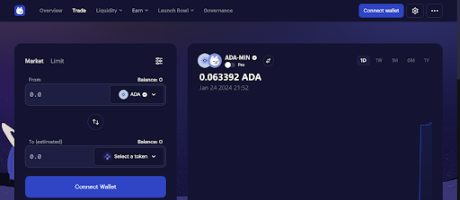
You might not see the DAEDALUS wallet there, so just create a “MinWallet” by clicking on it, then click on “New Wallet.” Copy your 24-word secret phrase down, write it down in a safe place, verify your secret phrase, create your MinWallet password, Now your MinWallet is ready to be used.
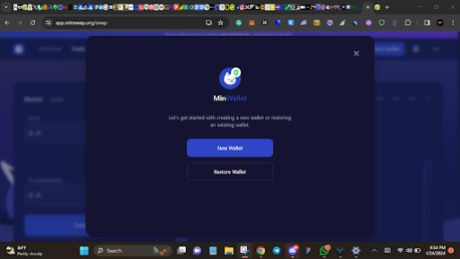
How To Buy ADA On Centralized Exchanges And Send To Your MinWallet
You need some ADA tokens in your wallet to make your transactions. You can buy your ADA from centralized exchanges (CEX) like ByBit, Binance, OKX, and MEXC, etc. In this case, we will use Binance.
Once the ADA is purchased, copy your MinWallet address, go to Binance, buy your ADA, and then go to “Withdraw.” Paste the MinWallet address you copied in the box to input your address, and Cardano will be automatically filled as your transfer network. Input the amount of ADA you want to transfer, then click on the “Withdraw” button.
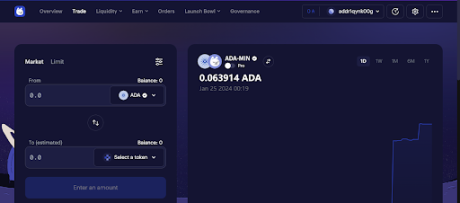
How To Trade Crypto Tokens On MinSwap
To buy tokens, go to Coingecko and search for the token on the Cardano Blockchain Network you want to buy. Alternatively, you can go to the social media pages of the token you want to make sure you have the correct coin. Go back to MinSwap, click on the denominator token button, input the name of the token you want to buy, and select it.
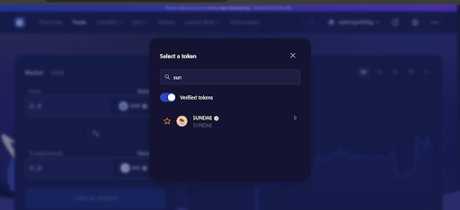
Input the amount of ADA you want to swap for that token and swap it. If you want to sell, just switch their positions and swap.
Checking Prices Of Cardano-Based Tokens
Knowing how to check the price action of tokens when trading on blockchains such as Cardano is important for investors to make the best decisions. For the Cardano network, data trackers such as TapTools is the one-stop-shop for all things Cardano charts.
Just go to TapTools, click the Search bar, and input the name of the token you want to check. In this case, we’re using SUNDAE.
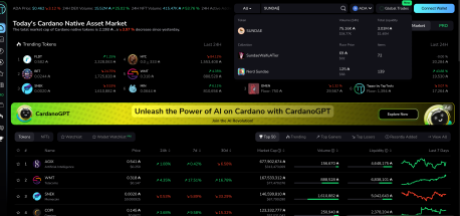
Choose the correct token and click on it, and TapTools will show you the price chart for that token. By using TapTools, you will be able to keep track of the price and follow how your token is doing, as shown below:
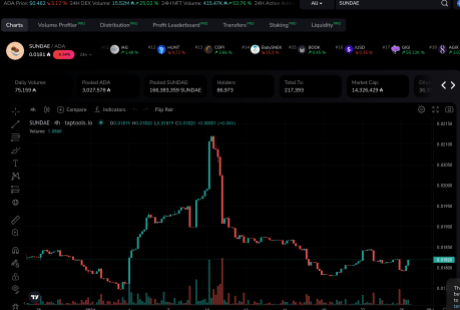
Interestingly, TapTools also has its own inbuilt decentralized exchange (DEX) for those who want to do everything in the same place. All you have to do is connect your wallet similarly to connecting to MinSwap as illustrated above, pick the token you want to swap to, enter the amount of ADA you want to swap, and click “Swap”. The DEX is visible on the right-hand side when you open the chart of a token.
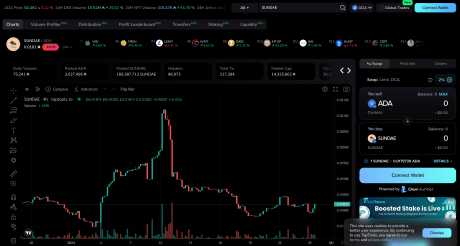
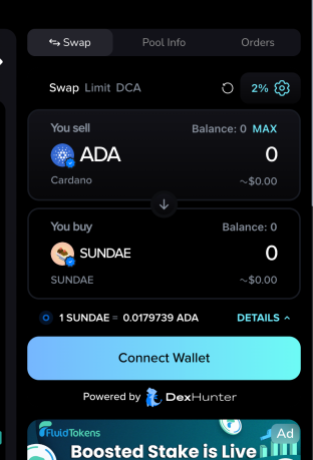
Conclusion
Trading on the Cardano (ADA) network is quick and seamless due to its fast transaction speeds and low fees. However, like with any crypto trading, it does carry its own risk, which could be a partial or total loss of capital.
How To Buy, Sell, And Trade Crypto Tokens On The Cardano (ADA) Network
[toc]
The Cardano Network is a decentralized proof-of-stake blockchain platform with smart contract support and uses its own native token ADA, just like the Ethereum blockchain. Cardano is often described as the Ethereum killer. However, Cardano also considers itself the updated version of Ethereum, which is currently the king of all altcoins, including ADA.
Cardano (ADA) The Supposed Ethereum Killer
It has been said that Cardano has anointed itself as a third-generation crypto platform which it regards to Ethereum as the second generation. Cardano has deemed itself fit to be a threat or competitor to Ethereum as they are both similar in so many ways, including the fact that Cardano (ADA) was created by one of the co-founders of Ethereum, Charles Hoskinson.
As Ethereum is having a hard time with high gas fees issues and slow transaction times, Cardano is all set up to take their share and make a name for themselves in the NFT, DeFI, and Stablecoin market. Cardano aims to be scalable and low-cost for users compared to Ethereum, its major competitor.
It enables owners of their native token ADA to help operate the network and vote on changes to the software roles. A lot of developers now use the Cardano Blockchain for Smart contracts and building decentralized applications (dApps).
Cardano Continues To Evolve: Hard Forked From Byron To Shelley
Cardano has been releasing its blockchain in stages with the aim of releasing better, cleaner, and more secure codes. They continued to evolve as the Cardano blockchain hard forked from Byron, a federated and static model, to Shelley, a more dynamic and decentralized model
A hard fork means or is described as a radical change in the blockchain, but in the case of Cardano, The blockchain hard fork was unique because instead of the blockchain radical change, it ensured a smooth transition from the old protocol to a new protocol while saving the history of the previous blocks. This means the Cardano blockchain contains the Byron blocks and after a certain transaction period, it adds the Shelley blocks.
Shelley was upgraded, and the Shelley protocol upgrade added a new feature that enabled different kinds of Smart contract use cases, which included the creation and transactions with multi-asset tokens. It also established support for the Voltaire voting mechanism. The Shelley protocol hard fork upgrade of March 2021 called “Mary” introduced native token and multi-asset support on the Cardano Blockchain.
Mary allows users to create their own tokens that run on the Cardano network natively, just like Cardano’s native token ADA. Similar to the ERC20 tokens that can be created and transacted on the Ethereum network, Native tokens will open up this same functionality to Cardano.
How Does Cardano (ADA) Work?
The Cardano (ADA) Blockchain is made up of two main components, which are the Cardano Computational Layer (CCL) and the Cardano Settlement Layer (CSL).
The Cardano Computational Layer (CCL):
The Cardano Computational Layer (CCL) consist of the Ouroboros consensus protocol and Proof of stake, which are the backbone of the Cardano blockchain. They help to run smart contracts, it also ensures compliance and security. Lastly, allow other key advanced features and functionalities such as identity recognition and blacklisting.
The Cardano Settlement Layer (CSL):
The Cardano Settlement Layer (CSL) serves as the accounting layer of the Cardano blockchain where its native token holders can send and receive their ADA immediately with minimal transaction fees.
Blockchain Industry Issues Cardano Aims To Solve
- To create a secure voting mechanism for token holders.
- To Separate accounting and computation layers.
- To create an infinitely scalable consensus mechanism.
- To use mathematics to provide a provably secure blockchain that is less susceptible to attacks.
Benefits And Advantages of Cardano (ADA) Blockchain
Decentralization: The Cardano network is designed to promote decentralization, and the founder of ADA Charles Hoskinson, is confident that the network would be 50 to 100 times more decentralized than Bitcoin.
High scalability: The recent Cardano Blockchain Vasil hard fork solves scalability issues as it introduced critical updates that streamline transaction processing, ultimately increasing the transactions per second (tps) Cardano’s blockchain can handle to significantly boost transaction processing speeds, unlike Ethereum.
Multilayer security measures: Cardano has a multilayer architecture that separates the computation layer from the accounting layer and also the Ouroboros proof of stake algorithm reduces the surface attack and ensures good security without falling short on decentralization.
Low gas fees: Unlike Ethereum, Cardano has low transaction or gas fees which makes it more appealing to users and developers.
Environmentally friendly ecosystem: Cardano is designed to be accessible to all persons, no matter their level of skill, from novices to advanced users.
Strong Community: A project is as strong as its community and Cardano has a strong community of active users, developers, researchers, and founders all work together to make the project a very good one.
How To Buy, Sell, And Trade Crypto Tokens On The Cardano (ADA) Network
To see a full picture of the Cardano ecosystem, go to CardanoCube. CardanoCude has information on the applications on the Cardano Blockchain, ranging from DEXes to Liquidity to Wallets, Marketplaces, DeFI, Infrastructure, and Launchpads, in case you want to launch a project on the Cardano Blockchain. There are also Metaverse platforms, Gaming platforms, AI tools, Community & DAO, Developer Tools, Meme Coin, and so many more.

To buy and sell tokens on the Cardano (ADA) network, you need to get a wallet. The official wallet created by the Cardano developer IOG is called DAEDALUS. DAEDALUS is a desktop or PC secure wallet for the ADA cryptocurrency that downloads a full copy of the Cardano Blockchain, and it independently validates every transaction in its history, ensuring maximum security.
How To Install, Set Up, and Use DAEDALUS Wallet
Make sure you download the installation file from the DAEDALUS official website daedaluswallet.io. Once the website is open, click on “Download” and then choose your operating system: either macOS, Linux, or Windows. Start the downloading process by clicking on “Download DAEDALUS.”

Install it, and once DAEDALUS is launched, you will need to configure the general settings and click on “Continue.” Read, and accept the terms and conditions.

Please note that the blockchain must be completely synced before you can use your wallet.

To create a new wallet, click on the “Create” button, give your wallet a “Name,” and Create your “Spending password”. You will need your spending password later to make transactions. It will also Encrypt your wallet file in the dataless directory.

After the setup, the “Recovery phase” page will pop up, and you will be given the 24-word secret phrase that you can use to recover your account in case your laptop is stolen or broken.

Ensure to write down your secret phrase and keep it in a safe place, after verifying your secret phrase your wallet is all set up.

Click on “Send” to send coins and Click on “Receive” to receive coins, select one of the automatic recipient addresses to receive your coins for other exchanges.

How To Use The Wallet Function On Minswap Instead Of Daedalus
Minswap is a multi-pool decentralized exchange (DEX) on Cardano (ADA) where you can swap tokens with minimal time, cost, and maximum ease.

The Minswap website is user-friendly and easy to trade on. Go to the website, click on “Trade,” then click on “Connect wallet.”

You might not see the DAEDALUS wallet there, so just create a “MinWallet” by clicking on it, then click on “New Wallet.” Copy your 24-word secret phrase down, write it down in a safe place, verify your secret phrase, create your MinWallet password, Now your MinWallet is ready to be used.

How To Buy ADA On Centralized Exchanges And Send To Your MinWallet
You need some ADA tokens in your wallet to make your transactions. You can buy your ADA from centralized exchanges (CEX) like ByBit, Binance, OKX, and MEXC, etc. In this case, we will use Binance.
Once the ADA is purchased, copy your MinWallet address, go to Binance, buy your ADA, and then go to “Withdraw.” Paste the MinWallet address you copied in the box to input your address, and Cardano will be automatically filled as your transfer network. Input the amount of ADA you want to transfer, then click on the “Withdraw” button.

How To Trade Crypto Tokens On MinSwap
To buy tokens, go to Coingecko and search for the token on the Cardano Blockchain Network you want to buy. Alternatively, you can go to the social media pages of the token you want to make sure you have the correct coin. Go back to MinSwap, click on the denominator token button, input the name of the token you want to buy, and select it.

Input the amount of ADA you want to swap for that token and swap it. If you want to sell, just switch their positions and swap.
Checking Prices Of Cardano-Based Tokens
Knowing how to check the price action of tokens when trading on blockchains such as Cardano is important for investors to make the best decisions. For the Cardano network, data trackers such as TapTools is the one-stop-shop for all things Cardano charts.
Just go to TapTools, click the Search bar, and input the name of the token you want to check. In this case, we’re using SUNDAE.

Choose the correct token and click on it, and TapTools will show you the price chart for that token. By using TapTools, you will be able to keep track of the price and follow how your token is doing, as shown below:

Interestingly, TapTools also has its own inbuilt decentralized exchange (DEX) for those who want to do everything in the same place. All you have to do is connect your wallet similarly to connecting to MinSwap as illustrated above, pick the token you want to swap to, enter the amount of ADA you want to swap, and click “Swap”. The DEX is visible on the right-hand side when you open the chart of a token.


Conclusion
Trading on the Cardano (ADA) network is quick and seamless due to its fast transaction speeds and low fees. However, like with any crypto trading, it does carry its own risk, which could be a partial or total loss of capital.
How To Buy, Sell, And Trade Tokens On The BSC Network
The captivating Binance Smart Chain (BSC) Network has morphed into a powerful force within the blockchain ecosystem, offering various benefits and opportunities for users and developers alike. Introduced by Binance, a top player in the global cryptocurrency exchange realm, BSC provides a robust and efficient infrastructure for decentralized applications (dApps) and digital asset transactions.
The key advantage of the BSC network is its high-speed and low-cost transactions. With its standout consensus mechanism, BSC achieves fast block confirmations, enabling quick and seamless transfers of digital assets. This scalability advantage makes BSC an attractive choice for users who value speed and efficiency in their transactions.
Advantages Of The Binance Smart Chain (BSC) Network
The Binance Smart Chain (BSC) offers several advantages that have contributed to its popularity and growth within the blockchain ecosystem. Here are some key advantages of the BSC network:
High Speed and Low Transaction Fees: BSC is known for its fast block confirmations, which result in quick transaction processing times. This speed is achieved through its unique consensus mechanism. Additionally, BSC’s low transaction fees have made it a preferred platform for developers and users.
Compared to other popular blockchain networks, BSC offers significantly lower transaction costs, making it more accessible for individuals and businesses of all sizes. This cost-effective system has aided the exponential growth of decentralized finance (DeFi) applications on the BSC network by providing a wide range of financial services to users around the world.
Scalability: BSC has been designed to handle high transaction volumes, allowing for the smooth and efficient execution of decentralized applications (dApps). This advantage enables BSC to accommodate the growing demands of users and developers without compromising performance.
Compatibility with Ethereum: The compatibility of BSC with the Ethereum Virtual Machine (EVM) has made it easy for developers to port their existing Ethereum-based projects to BSC, expanding the pool of available applications.
This opens up a world of possibilities, as it expands the range of applications available on BSC, offering users a greater selection of innovative and diverse decentralized applications to choose from. This interoperability has fostered innovation and attracted a diverse range of projects, including decentralized exchanges, yield farming platforms, and NFT marketplaces.
The close integration between BSC and the Binance exchange also creates a host of advantages for users. The seamless connection between these two platforms facilitates effortless token swaps and transfers.
Related Reading: Celestia Network: How To Stake TIA And Position For 5-Figure Airdrops
This integration enhances overall liquidity, ensuring that users have quick and convenient access to a diverse range of digital assets. Whether it’s trading, diversifying portfolios, or exploring new investment opportunities, the close relationship between BSC and Binance empowers users with a seamless and detailed experience in the world of digital assets.
Trading On The BSC Network
Decentralized exchanges (DEXs) on the Binance Smart Chain (BSC) network provide traders with a range of features and opportunities to enhance their trading experience. Here’s an elaboration on the features of DEXs on BSC:
Automated Market Makers (AMM): DEXs on BSC leverage AMM protocols to enable token swaps. AMM algorithms automatically set token prices based on supply and demand dynamics within liquidity pools. This feature eliminates the need for traditional order books and enables continuous liquidity, allowing traders to execute swift and efficient trades.
Yield Farming: Yield farming is a popular practice in the decentralized finance (DeFi) space, and many BSC DEXs offer yield farming opportunities where traders provide liquidity to specific token pairs by depositing their assets into smart contract-based liquidity pools. In return, they receive liquidity provider (LP) tokens, which represent their share of the pool.
Traders can then stake these LP tokens in yield farming programs to earn additional tokens or rewards. Yield farming enables traders to earn passive income by utilizing their idle assets effectively.
Liquidity Pools: These are fundamental components of DEXs on BSC which consist of pairs of tokens that are used for trading. Traders can contribute their assets to these pools and become liquidity providers.
By providing liquidity, traders help ensure that there is sufficient liquidity available for trading. In return for their contribution, liquidity providers earn a portion of the trading fees generated by the DEX. This incentivizes traders to provide liquidity, as they can earn fees from the trading activity in the pool.
Token Trading: DEXs on BSC offer traders the ability to trade a wide range of tokens. These tokens can include native tokens of projects built on the BSC network, as well as tokens that have been bridged from other blockchains, including Ethereum.
Traders have access to various trading pairs, allowing them to buy and sell tokens directly from their wallets. The availability of diverse tokens and trading pairs provides traders with abundant opportunities to explore various markets and investment opportunities.
Additionally, the Binance Smart Chain (BSC) is a modified Ethereum fork which simply means that it is compatible with the Ethereum network. Both of these blockchain networks have similar infrastructure, which is why they have the same address in your wallet.
This is to ensure that your funds are not permanently lost when you send them via the wrong network. Simply put, if you send a token to your ETH via the BSC network, the funds will still be on the blockchain and you’ll be able to retrieve them.
How To Get Started On The BSC Network
To buy and sell tokens on the Binance Smart Chain (BSC) network, you will first need to get a Metamask wallet and fund it with BNB tokens. MetaMask is a popular browser extension wallet commonly used for interacting with blockchain networks like Ethereum and Binance Smart Chain (BSC). It is available as a browser extension for popular browsers such as Google Chrome.
Ensure your Metamask Wallet has been added to your browser as an extension by clicking on the “Add to Chrome” icon on the top right as shown below:
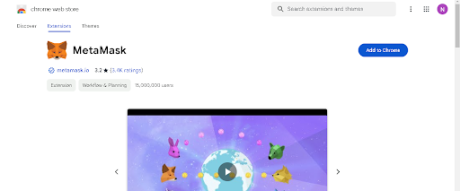
Once installed and set up, MetaMask allows users to manage their cryptocurrency wallets, interact with decentralized applications (DApps), and securely execute transactions on supported blockchain networks directly from their browsers. (Make sure to write down your seed phrase on a piece of paper and keep it safe. Do not store it online).
Next, add the BSC network to your Metamask wallet by following the instructions provided on the Metemask website here.
Getting BNB Tokens To Trade On The BSC Network
Once that is done, you need to fund your wallet with BNB before you can begin trading on the BSC network. You can buy BNB on centralized exchanges such as Binance, copy your wallet address from Metamask, and then send the BNB from Binance to your Metamask wallet.
You can also purchase BNB directly within the Metamask wallet using traditional payment methods such as credit or debit cards, PayPal, bank transfer, CashApp, etc.
Just click on the “Buy/Sell” button within Metamask which will open up the interface. Here, you can put how much BNB you want to buy in terms of dollar terms, pick your payment method, and then click “Buy”.
Note that to buy crypto directly within Metamask, you will need to provide info such as your country and state. However, it is a straightforward process that only takes a minute.
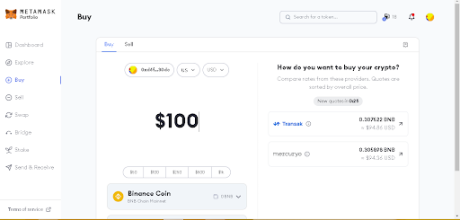
It’ll only take a couple of minutes at most for your BNB to arrive in your wallet. Once the BNB arrives, you are all set to begin trading tokens on the BSC network. So head over to Pancakeswap to get started on your trading journey.
How To Trade Tokens On The BSC Network Using PancakeSwap
PancakeSwap is the leading decentralized exchange on the BSC network. Here, users are able to buy and sell a large range of tokens, and it is a straightforward process.
Make sure you are on the correct Pancakeswap website to prevent your wallet from being drained. The next step is clicking on the “Connect Wallet” option on Pancakeswap at the top right corner as illustrated below:
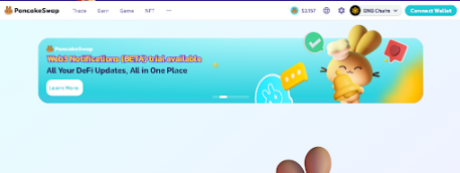
Connect to your preferred wallet as shown below. (In this case, it’s Metamask):
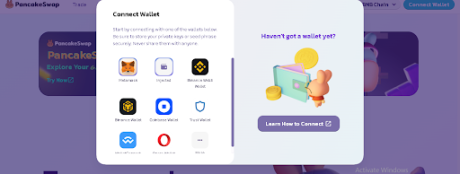
Once connected, switch Metamask to the BSC network. (If you’re already on the BSC network, you do not need to switch):
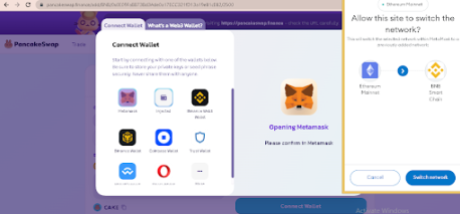
With MetaMask connected to the BSC network, go to PancakeSwap, then you can start trading on the BSC network using PancakeSwap. Search for the token you want to purchase using the name or the contract address.
Set slippage to auto to avoid having to manually set it with each swap. Once done, pick how much BNB (at the top) you want to convert to the new token (at the bottom), click on “Swap,” and confirm the transaction in your Metamask wallet.
Once the transaction is confirmed, the tokens will be sent to your wallet. To convert your tokens back into BNB, repeat this process by putting the new token at the top and picking BNB at the bottom. Click Swap and BNB will be sent to your wallet.
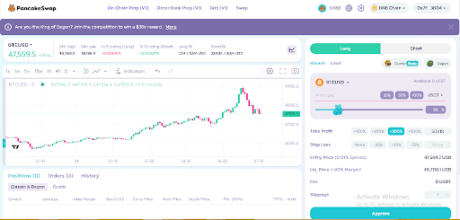
Buying And Selling Tokens With The Metamask Wallet
BSC Network users can also buy and sell tokens using the Metamask extension wallet already connected to the BSC network.
To do this, make sure you’re connected to the BSC network and have BNB to swap and pay for gas fees. Then navigate to the “Swap” button as shown below. This will take you to the Swap interface inside Metamask.
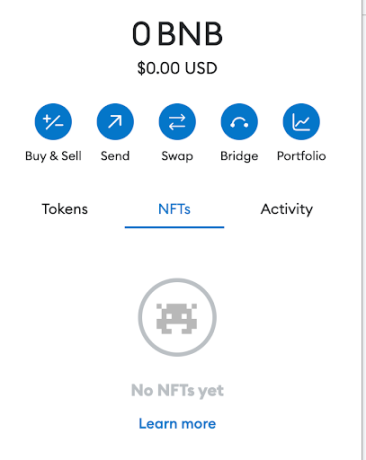
Here, you can also search for tokens using the name or the contract address, just like on Pancakeswap. Input the amount of BNB you want to swap, confirm that you have the correct token, and then click “Swap.” Once the transaction is confirmed, the tokens you just bought will be sent to your wallet.
Tracking Token Prices On The BSC Network
BSC network users can leverage on-chain tools such as Dextools to access detailed market insights about a particular token such as price and contract information to enable them to make informed trading decisions.
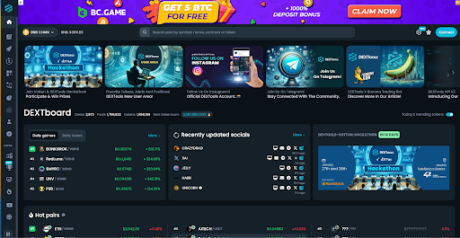
Dextools offers a range of features that are particularly beneficial for users on the BSC network. One notable feature is the ability to check charts, providing real-time and historical price data for various tokens. These charts enable users to analyze price trends, trading volumes, and other relevant metrics, helping them identify potential entry or exit points for their trades, as shown below:
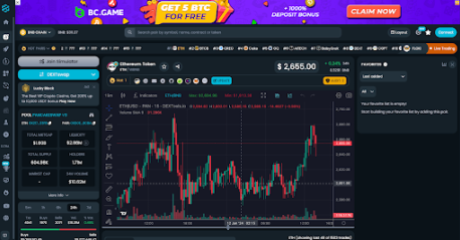
In addition to charting capabilities, Dextools provides a “Contract Audit” feature that is especially valuable for BSC users. This feature allows users to check the audit score of a smart contract before investing in a token. Audits assess the security and reliability of a contract’s code, highlighting potential vulnerabilities or risks.
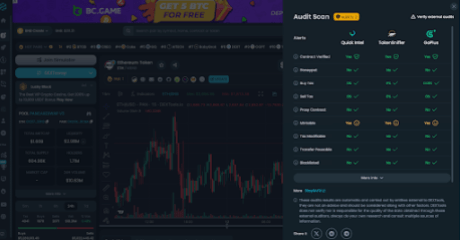
By accessing the audit score through Dextools, users can evaluate the level of trustworthiness and credibility of a token’s underlying smart contract, minimizing the chances of falling victim to scams or vulnerabilities.
Conclusion
The BSC network has become popular within the blockchain ecosystem due to its advantages and has attracted a diverse range of projects and users. BSC’s compatibility with Ethereum facilitates seamless token transfers between the two networks, enhances diversification of development and usage, and promotes collaboration within the broader blockchain ecosystem.
Additionally, it offers interoperability, allowing developers to easily port existing Ethereum-based applications and assets to BSC. This compatibility grants access to the extensive Ethereum ecosystem, enabling users to leverage the infrastructure and liquidity of Ethereum while benefiting from BSC’s faster transactions and lower fees.
BSC’s combination of interoperability, accessibility to liquidity, and enhanced transaction efficiency makes the BSC network a compelling choice for both developers and users, solidifying its position as a prominent player in the evolving blockchain landscape.
LayerZero Confirms Airdrop Plans, Boosting Some Ecosystem Projects
As of Friday, LayerZero has not outright mentioned how it intends to reward users for using its network.
Starknet token distribution not yet finalized, despite speculation over portal screenshots

The Starknet Foundation is warning community members to be on the lookout for scams relating to circulating screenshots of early iterations of a token distribution portal.
Bitget, Floki teams accuse each other of manipulation after token listing

The teams for crypto exchange Bitget and Web3 protocol Floki blamed each other for allegedly misleading investors.
Bitget, Floki teams accuse each other of manipulation after token listing

The teams for crypto exchange Bitget and Web3 protocol Floki blamed each other for allegedly misleading investors.
Celestia’s TIA Token Trades at $3.15 on Futures Market Ahead of Airdrop
TIA, the native token of modular blockchain network Celestia, is trading at $3.15 on decentralized derivatives exchange Helix ahead being issued later this week.
Sam Altman’s Worldcoin Switches Orb Rewards Plan to Boost WLD Supply
Users will receive WLD tokens, instead of USDC, starting Tuesday, as per a new developer document.
JPEX crypto exchange launches asset-lock-up plan, as some users cry foul

JPEX has pushed ahead with its DAO Shareholder Dividend Scheme. However, some users claim their assets are being converted without their knowledge.
Tottenham Hotspur taps Chiliz blockchain for Web3 fan token

Spurs became the first Premier League team in two years to issue its own fan token on the Chiliz blockchain.
ETH developer programs AI-generated memecoin AstroPepeX using ChatGPT
“What if ChatGPT could deploy its own token?” You probably guessed the answer – AstroPepeX has been minted and is being traded on a handful of DeFi and centralized exchanges.
Telegram integrates TON crypto wallet, TON price jumps 7%

Messaging app Telegram endorsed TON network as its blockchain network of choice for Web3 infrastructure, boosting the TON token price by 7%.
